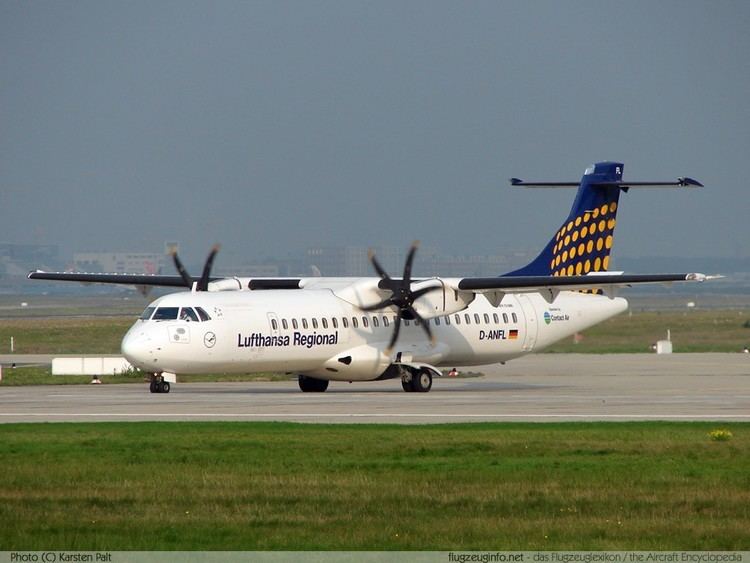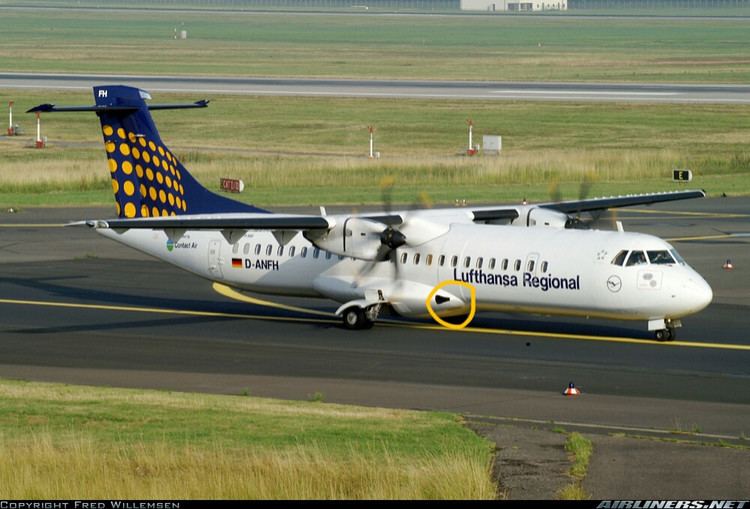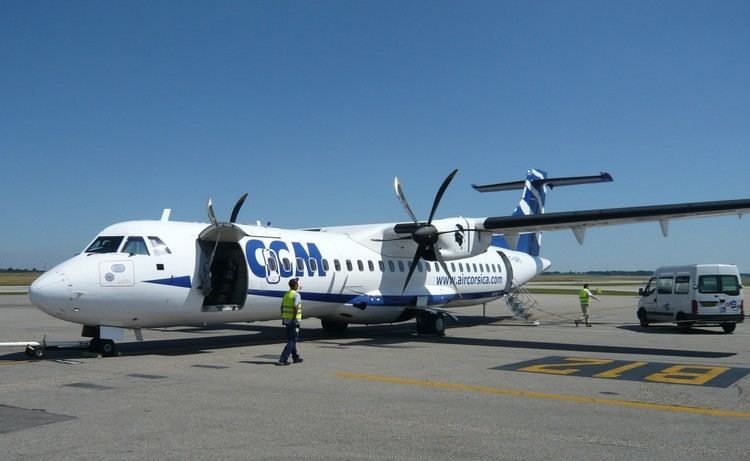Wingspan 27 m | Length 27 m | |
 | ||
Engine type Pratt & Whitney Canada PW100 Unit cost 16,500,000–20,000,000 USD (2008), 22,700,000–22,700,000 USD (2012) | ||
Intersky atr 72 600 full flight on brandnew aircraft hamburg friedrichshafen by airclips
The ATR 72 is a twin-engine turboprop short-haul regional airliner manufactured by the French-Italian aircraft manufacturer ATR. It was developed as a stretched variant of the ATR 42, and entered service in 1989. It has been typically employed as a regional airliner, although other roles have been performed by the type such as corporate transport, cargo aircraft and maritime patrol aircraft. Successive models of the ATR 72 have been introduced; a single aircraft can seat up to 78 passengers in a single-class configuration.
Contents
- Intersky atr 72 600 full flight on brandnew aircraft hamburg friedrichshafen by airclips
- Flybe atr 72 500 1 100 model aircraft
- Design and development
- ATR 72100
- ATR 72200
- ATR 72210
- ATR 72 212A
- Other versions
- Civilian operations
- Military operators
- Accidents and incidents
- Specifications ATR 72600
- References

Flybe atr 72 500 1 100 model aircraft
Design and development

The ATR 72 was developed from the ATR 42 in order to increase the maximum seating capacity (from 48 to 78) by stretching the fuselage by 4.5 metres (15 ft), increasing the wingspan, adding more powerful engines, and increasing fuel capacity by approximately 10 percent. The 72 was announced in 1986, made its maiden flight on 27 October 1988 and Finnair became the first airline to bring the aircraft into service a year later on 27 October 1989.

In most configurations, passengers are boarded using the rear door, (which is unusual for a passenger aircraft) as the front door is used to load cargo, although Finnair ordered their ATR 72s with a front passenger door so that they could utilize the jet bridges at Helsinki–Vantaa Airport, and Air New Zealand's standard rear door aircraft can use jet bridges at airports with this equipment. A tail stand must be installed when passengers are boarding or disembarking in case the nose lifts off the ground, which is common if the aircraft is loaded or unloaded incorrectly.

The ATR 72 is powered by two Pratt & Whitney Canada PW100-based turboprop engines with four or six-bladed propellers supplied by Hamilton Standard. Earlier ATR 72s were equipped with the PW124B engine rated at 2400 shp, whilst later aircraft were equipped with the PW127 rated at a maximum of 2750 shp for improved "hot and high" takeoff performance.

The aircraft does not have an auxiliary power unit (APU) as normally equipped. The APU is an option and would be placed in the C4 cargo section. Most air carriers normally equip the aircraft with a propeller brake (referred to as "Hotel Mode") that stops the propeller on the No. 2 (right) engine, allowing the turbine to run and provide air and power to the aircraft while on the ground without the propeller spinning.
At the end of 2014, ATR had received 1000 orders for the type and delivered 754, leaving a backlog of 246 aircraft. Since 2008, ATR has been a participant in the European Clean Sky Joint Technology Initiative and on 8 July 2015 a “green” ATR 72-600 flying technology demonstrator made its first flight; it is to be used to trial new composite insulating materials, electrical distribution system and energy dispersal modifications, and air conditioning systems to evaluate their effect on overall efficiency.
Speaking at the Farnborough Airshow in July 2016, the CEO of ATR Patrick de Castelbajac suggested that the company was examining the possibility of replacing the current Pratt & Whitney Canada PW127 engine with either a new offer from P&WC, or a GE38 derivative from GE Aviation. Although expressing his satisfaction with the current engine and supplier, Castelbajac noted the design's age and the need to remain competitive with the latest regional jets. To be worthwhile, any re-engine would require a 15% improvement in fuel-burn and 20-25% reduction of direct maintenance costs. Castelbajac sees the potential re-engine as a "bridge" to the eventual development of a larger 100-seat aircraft.
ATR 72–100
Two sub-types were marketed as the 100 series (−100).
ATR 72–200
Two sub-types were marketed as the 200 series (−200). The −200 was the original production version, powered by Pratt & Whitney Canada PW124B engines rated at 2,400 shp (1,800 kW).
ATR 72–210
Two sub-types were marketed as the 210 series (−210), the −211, (and with an enlarged cargo door, called the −212), is a −200 with PW127 engines producing 2,750 shp (2,050 kW) each for improved performance in hot and high-altitude conditions. The sub-types differ in the type of doors and emergency exits
ATR 72-212A
Certified in January 1997 and fitted with either PW127F or PW127M engines, the −212A is an upgraded version of the −210 using six-bladed propellers on otherwise identical PW127F engines. Other improvements include higher maximum weights and superior performance, as well as greater automation of power management to ease pilot workload.
Other versions
Bulk Freighter (tube versions) and ULD Freighter (Large Cargo Door). ATR unveiled a large cargo door modification for all ATR 72 at Farnborough 2002, coupled with a dedicated cargo conversion. FedEx, DHL, and UPS all operate the type.
The ATR 72 ASW integrates the ATR 42 MP (Maritime Patrol) mission system with the same on-board equipment but with additional ASW capabilities. An anti-submarine warfare (ASW) variant of the −500 (itself a version of the maritime patrol variant of the ATR 42–500) is also in production and has been selected by the Italian Navy for ASW and anti-surface warfare (ASuW) duties. Italy's order of four aircraft will begin to be delivered in 2012. For the ASW and ASuW missions, the aircraft will be armed with a pod-mounted machine gun, lightweight aerial torpedoes, anti-surface missiles, and depth charges. They will be equipped with the Thales AMASCOS (Airborne Maritime Situation and Control System) maritime surveillance system as well as electronic warfare and reconnaissance systems, so that they may also be used for maritime search and rescue operations.
A VIP version of the −500 is available with a luxury interior for executive or corporate transport.
During the mid-1980s, the company investigated a 78-seat derivative of the ATR 72. This would have been powered by two Allison AE2100 turboprops (turbofans were also studied for a time) and would have had a cruising speed as high as 330kt. The ATR-82 project (as it was dubbed) was suspended when AI(R) was formed in early 1996.
This proposed version targeted the increasing demand of worldwide cargo and express mail markets, where the aim is to allow operators to supplement their passengers flights with freighter flights.
In Quick Change configuration, the smoke detector is equipped alongside other modifications required in order to meet the certification for full freight operations. The aircraft was equipped with a larger cargo door (1.27 m [50 in] wide and 1.52 m [60 in] high) and low door-sill height of an average 1.2 m (4 ft), facilitating containerized freight loading.
It takes 30 minutes to convert the aircraft on ATR 42, while for ATR 72, it takes 45 minutes. Each optimized container has 2.8 m3 (99 cu ft) of usable volume and maximum payload is 435 kg (960 lb).
Civilian operations
Main ATR 72 operator airlines as of January 19, 2017 (with 15 aircraft or more)
In February 2016, ATR signed a deal with Iran Air for 20 ATR 72-600 planes with an option for 20 more.
Military operators
The Turkish Navy, which initially decided to purchase ten ATR 72–500 MPA, later modified its order to eight ATR 72–600 aircraft: Two 72–600 TMUA (utility) versions, and six 72–600 TMPA (ASW/ASuW) versions. The two ATR 72–600 TMUA aircraft were delivered to the Turkish Navy in 2013.
Accidents and incidents
Specifications (ATR 72–600)
Data from ATR,
General characteristics
Performance
